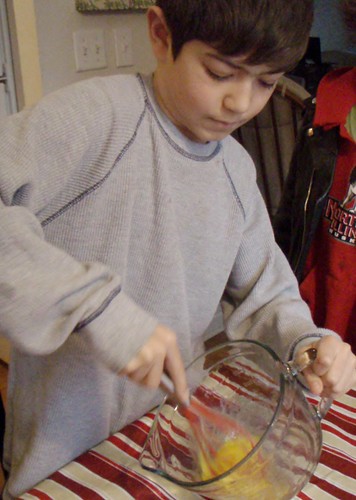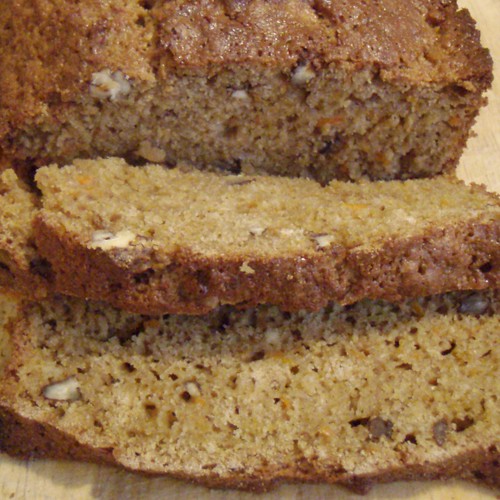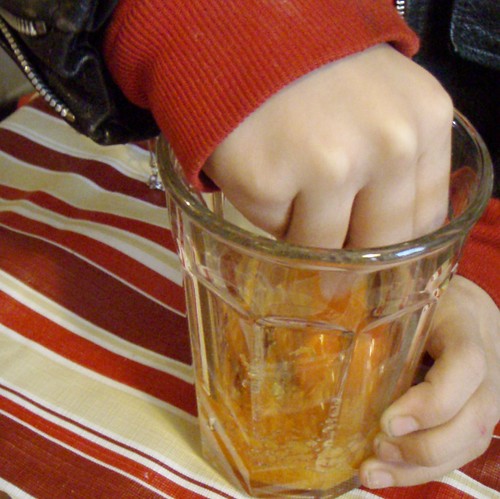Experiment: Solubility and Polarity
Note: Don't throw away the experiment when it's done! You need it as an ingredient in the recipe below!

2/3 c. water
1/8 c. (2 tablespoons) vegetable oil
1 c. coarsley grated carrot (You will only use about a tablespoon; don't use prepackaged shredded carrots - you need the juice!)
2 clear cups
This experiment took a couple of tweaks before I figured it out, but it's pretty cool: Measure the oil and the water into two separate clear cups. Mix about 1 tbsp grated carrot into the oil; stir for at least one minute.
Gently pour the carrot/oil mixture into the water. Allow to stand for a minute or two and observe what happens.
The coloring in carrots is a fat-based vitamin, beta carotene (AKA Vitamin A) and is soluble (dissolves) in oil. This is why the oil turned yellow.
The reason that the oil and water didn't mix is that water molecules have a positive charge at one end and a negative charge at the other; they stick to each other in the same way magnets do. Oil molecules have no charge; they're non-polar. Because of this, oil molecules are more attracted to each other than to water molecules, and water molecules are more attracted to each other than to oil molecules, so the two liquids stay separate. Oil, of course, is less dense than water, so it winds up on top.
If you stir the carrots/oil/water mixture, you will color the water orange as well - we did this the first time we tried this experiment. This is because bits of carrot get suspended (float in place) in the water, but not because the carrots dissolved.
The reason that the oil and water didn't mix is that water molecules have a positive charge at one end and a negative charge at the other; they stick to each other in the same way magnets do. Oil molecules have no charge; they're non-polar. Because of this, oil molecules are more attracted to each other than to water molecules, and water molecules are more attracted to each other than to oil molecules, so the two liquids stay separate. Oil, of course, is less dense than water, so it winds up on top.
If you stir the carrots/oil/water mixture, you will color the water orange as well - we did this the first time we tried this experiment. This is because bits of carrot get suspended (float in place) in the water, but not because the carrots dissolved.
Now, turn your experiment into carrot bread! First, preheat the oven to 325 degrees.
Find a large bowl and measure in:
2 c. flour
1 tsp. cinnamon
1 tsp. baking powder
1/2 tsp. baking soda
1/4 c. chopped nuts
Whisk thoroughly to combine.
 In another bowl, whisk together
In another bowl, whisk together2 eggs
and add:
1/2 tsp. salt
1/2 c. sugar
1/2 c. packed brown sugar
1/4 c. dry milk powder
1 tsp. vanilla
All the liquid and carrots from your solubility experiment (2/3 c. water, 2 tablespoons vegetable oil and 1 c. coarsley grated carrot)
 Add liquid ingredients to dry ingredients. Fold together until all the flour is moistened, but do not overmix.
Add liquid ingredients to dry ingredients. Fold together until all the flour is moistened, but do not overmix.Bake in a 8 1/2 x 4 1/2 loaf pan at 325 degrees for 60-70 minutes.
Cool 10 minutes in pan, then remove. Slice and serve!








No comments:
Post a Comment